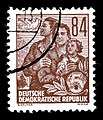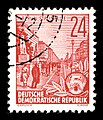You can help expand this article with text translated from the corresponding article in German. (May 2021) Click for important translation instructions.
|
| This article needs additional citations for verification. Please help improve this article by adding citations to reliable sources. Unsourced material may be challenged and removed. Find sources: "Karl-Marx-Allee" – news · newspapers · books · scholar · JSTOR (May 2021) (Learn how and when to remove this message) |
 Aerial view of Karl-Marx-Allee with the twin towers of Frankfurter Tor in the background Aerial view of Karl-Marx-Allee with the twin towers of Frankfurter Tor in the background The western part of the boulevard is marked by panel buildings (1967) The western part of the boulevard is marked by panel buildings (1967) | |
 | |
| Former name(s) |
|
| Part of | |
| Namesake | Karl Marx |
| Type | Boulevard |
| Length | 2.3 km (1.4 mi) |
| Width | 90 m (300 ft) |
| Location | Berlin, Germany |
| Quarter | Mitte, Friedrichshain |
| Nearest metro station | |
| Coordinates | 52°31′04″N 13°26′07″E / 52.51769°N 13.43525°E / 52.51769; 13.43525 |
| West end |
|
| Major junctions |
|
| East end | |
Karl-Marx-Allee (Karl Marx Avenue) is a boulevard built by the GDR between 1952 and 1960 in Berlin Friedrichshain and Mitte. Today the boulevard is named after Karl Marx. It should not be confused with the Karl-Marx-Straße in the Neukölln district of Berlin.
The boulevard was named Stalinallee between 1949 and 1961 (previously Große Frankfurter Straße), and was a flagship building project of East Germany's reconstruction programme after World War II. It was designed by the architects Hermann Henselmann, Hartmann, Hopp, Leucht, Paulick, and Souradny to contain spacious and luxurious apartments for workers, as well as shops, restaurants, cafés, a tourist hotel, and an enormous cinema, the Kino International.
The avenue, which is 90 metres (300 ft) wide and 2.3 kilometres (1.4 mi) long, is lined with monumental eight-story buildings designed in the wedding-cake style, the socialist classicism of the Soviet Union. At each end are dual towers at Frankfurter Tor and Strausberger Platz designed by Hermann Henselmann. The buildings differ in the revetments of the facades which contain often equally, traditional Berlin motifs by Karl Friedrich Schinkel. Most of the buildings are covered by architectural ceramics.
By 1989 half the tiles on the outer facades of these buildings had fallen off, necessitating sheltering structures over the sidewalks in some places to protect pedestrians.
A monumental Stalin statue presented to the East German government by a Komsomol delegation on the occasion of the Third World Festival of Youth and Students was formally dedicated on 3 August 1951 after being temporarily placed at a location on the newly designed and impressive boulevard. It remained there until 1961 when it was removed in a clandestine operation in the course of de-Stalinization.
On 17 June 1953 the Stalinallee became the focus of a worker uprising which endangered the young state's existence. Builders and construction workers demonstrated against the communist government, leading to a national uprising. The rebellion was crushed with Soviet tanks and troops, resulting in the deaths of 125 people.
Later the street was used for East Germany's annual May Day parade, featuring thousands of soldiers along with tanks and other military vehicles to showcase the power and the glory of the communist government.
De-Stalinization led to the renaming of the street, after the founder of Marxism, in late 1961. Since the collapse of Eastern European communism in 1989/1990, renaming the street back to its prewar name Große Frankfurter Straße has periodically been discussed, so far without conclusive results.
The boulevard later found favour with postmodernists, with Philip Johnson describing it as 'true city planning on the grand scale', while Aldo Rossi called it 'Europe's last great street.' Since German reunification most of the buildings, including the two towers, have been restored.
Commerce
The boulevard developed into a commerce-centre in the GDR. It also served the ideological function of introducing visitors to the culture of its "socialist sister states". Commerce was a mixed experience for visitors from the West. Most stores would not accept payment for purchased items without a receipt from an East German bank showing that the West German Marks had been exchanged for East German Marks at a rate of 1:1. In the West, the exchange rate was 1:8 but most restaurants and bookstores were not concerned with these requirements so bargains were to be found.
"Stalin's bathroom"
In February 2009, an anonymous author edited the article "Karl-Marx-Allee" in the German-language edition of Misplaced Pages, claiming that during the time of the GDR the road had acquired the nickname "Stalin's bathroom" due to the buildings' tiled façades. Subsequently, several media outlets reiterated this claim. No alternative verification for the term was given, making it a self-referential claim.
After a letter written to the Berliner Zeitung questioned whether the term "Stalin's bathroom" had actually been in common use during the GDR period, Andreas Kopietz, a journalist at the newspaper, published an article admitting he had invented the phrase and identifying himself as the original anonymous Misplaced Pages editor, allowing the record to be set straight.
In popular media
The boulevard is referenced under its former name, the Stalinallee, in the satirical poem "Die Lösung" by Bertolt Brecht about the East German uprising of 1953.
Photographs
-
 Domed tower at Frankfurter Tor
Domed tower at Frankfurter Tor
-
 Façade of a Stalinist-era apartment block
Façade of a Stalinist-era apartment block
-
 Façade of a Stalinist-era apartment block
Façade of a Stalinist-era apartment block
-
 Façade detail
Façade detail
-
 Karl-Marx-Allee looking towards the Berlin TV Tower.
Karl-Marx-Allee looking towards the Berlin TV Tower.
-
 Strausberger Platz, near the western end of the boulevard
Strausberger Platz, near the western end of the boulevard
-
 Karl-Marx-Allee with Frankfurter Tor and Television Tower
Karl-Marx-Allee with Frankfurter Tor and Television Tower
-
 Closeup of a Stalinist-era building
Closeup of a Stalinist-era building
-
 Stalinallee, 1950
Stalinallee, 1950
-
 Stalinallee, 1959
Stalinallee, 1959
-
 "5-year Plan" postage stamp series, 1953: A family standing before a high-rise near the Weberwiese subway station
"5-year Plan" postage stamp series, 1953: A family standing before a high-rise near the Weberwiese subway station
-
 Berlin, Stalinallee
Berlin, Stalinallee
-
 Trabants on Karl-Marx-Allee
Trabants on Karl-Marx-Allee
-
 Aerial view over Karl-Marx-Allee, 2019
Aerial view over Karl-Marx-Allee, 2019
See also
- Stalinist architecture
- Seven Sisters (Moscow)
- The Straße der Pariser Kommune ("Street of the Paris Commune") connects with Karl-Marx-Allee
References
- "Karl-Marx-Allee". Kauperts Straßenführer durch Berlin (in German). Kaupert [de]. Retrieved 15 October 2024.
- ^ "Karl-Marx-Allee | Friedrichshain, Berlin | Attractions". Lonely Planet. Retrieved 15 October 2024.
- ^ "Around Karl-Marx-Allee". berlin.de. State of Berlin. Retrieved 15 October 2024.
- "Stalinallee: Palaces for the workers". Visit Berlin. Berlin Tourismus & Kongress GmbH. Retrieved 2 July 2022.
- Ladd, Brian (1998). The Ghosts of Berlin: Confronting German History in the Urban Landscape. Chicago: University of Chicago Press. p. 187. ISBN 978-0-226-46762-7.
- "Karl-Marx-Allee, Berlin, information board | Flickr - Photo Sharing!". Flickr. 11 December 2012. Retrieved 4 February 2014.
- Das längste Baudenkmal Europas in Berliner Morgenpost. 1 March 2011.
- "Viel Platz, wenige Kunden". MOZ.de. Retrieved 4 February 2014.
- "Nachrichten" [News] (in German). BerlinOnline.de. 25 February 2011. Retrieved 4 February 2014.
- "Nachrichten" [News] (in German). BerlinOnline.de. 1 March 2011. Retrieved 4 February 2014.
- "Nachrichten" [News] (in German). BerlinOnline.de. 24 March 2011. Archived from the original on 5 September 2011. Retrieved 4 February 2014.
External links
- [REDACTED] Media related to Karl-Marx-Allee (Berlin) at Wikimedia Commons
- A photo tour of Karl-Marx-Allee
- Photo gallery of Karl-Marx-Alee architecture
